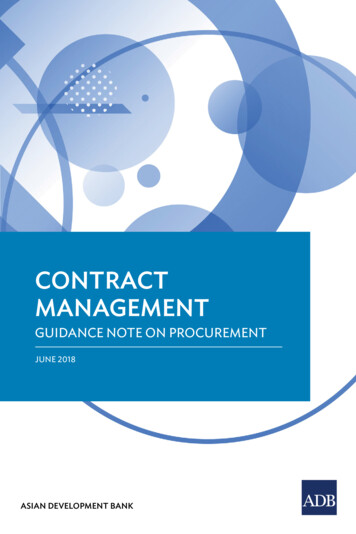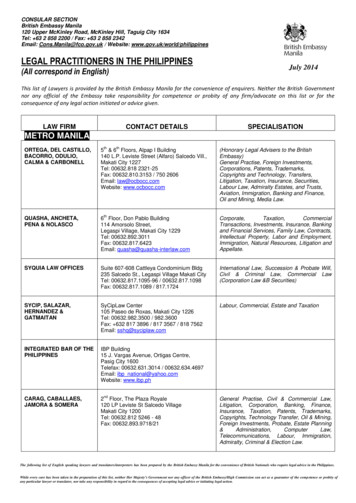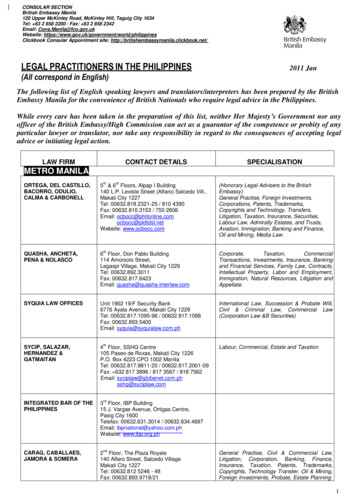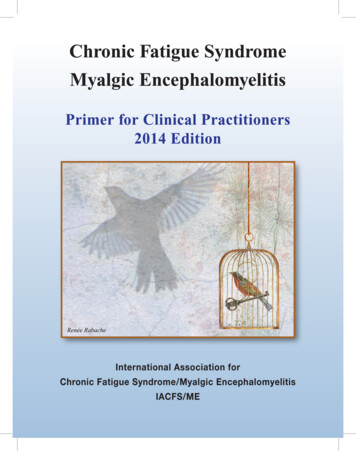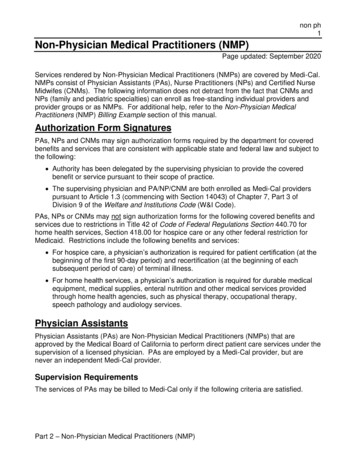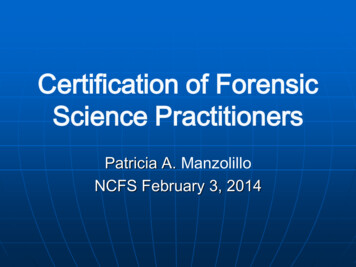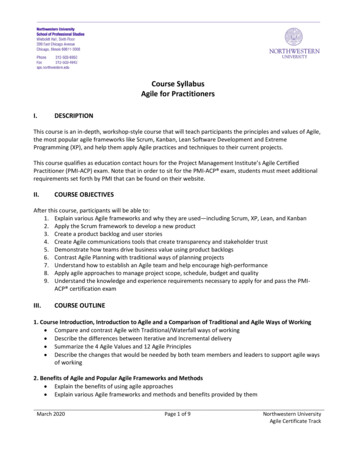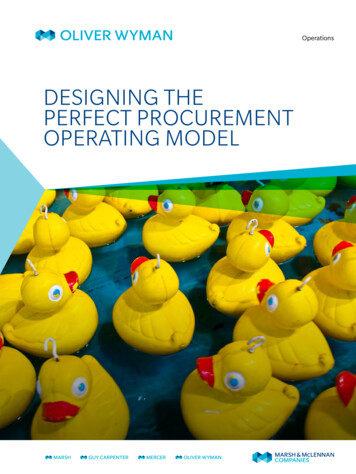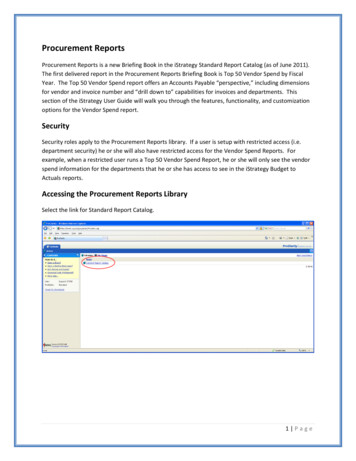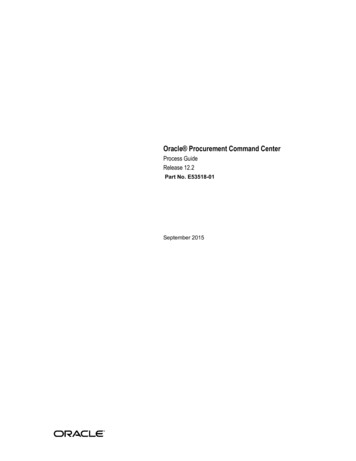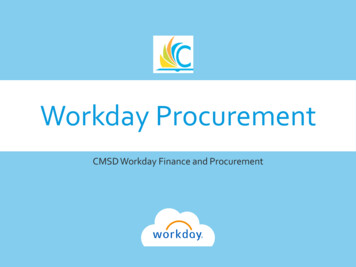
Transcription
FEBRUARY 2018PUBLIC PROCUREMENTGUIDANCE FORPRACTITIONERSon avoiding the most common errorsin projects funded by the EuropeanStructural and Investment Funds1
DISCLAIMERThis document contains guidance on how to avoid errors frequently seen in public procurement for projectsco-financed by the European Structural and Investment Funds. It is intended to facilitate the implementation of operational programmes and to encourage good practice. It is not legally binding but aims to providegeneral recommendations and to reflect best practice.The concepts, ideas and solutions proposed in the guidance are without prejudice to national legislation andshould be read and may be adapted taking into account the national legal framework.This guidance is without prejudice to the interpretation that the Commission may in the future give to anyprovision of the applicable legislation. This guidance does not commit the European Commission. Only theCourt of Justice of the European Union is competent to authoritatively interpret Union law.PrintISBN -CPDFISBN -N
PUBLIC PROCUREMENTGUIDANCE FORPRACTITIONERSon avoiding the most common errorsin projects funded by the EuropeanStructural and Investment Funds
Table of contentsGlossary of acronyms4Foreword7Introduction — How to use this guidance8Who is this guidance for?8What is the purpose of this guidance?8Structure of the guidance8Explanation of symbols: warnings and help for public buyers9Scope of the guidance9Key changes introduced by the public procurementDirective 2014/24/EU11New definitions, new thresholds, and a new category of contracting authority11Making SME participation in public contracts easier12More provisions on grounds for exclusion and award criteria13Improved safeguards against corruption13Including environmental, social and innovation policy goals in procurement procedures 14Electronic procurement14Changes in procedures14Changes in the scope of Directive 2014/24/EU151. Preparation and planning161.1. Assess future needs171.2. Engage stakeholders191.3. Analyse the market231.4. Define the subject matter281.5. Choose the procedure351.6. Plan the procedure512. Publication and transparency542.1. Draft procurement documents542.2. Define specifications and standards592.3. Define the criteria652
2.4. Set the time limits772.5. Advertise the contract813. Submission of tenders and selection of tenderers863.1. Ensure a delivery of tenders according to instructions863.2. Acknowledge receipt and open tenders873.3. Assess and select tenders884. Evaluation of tenders and award924.1. Set up the evaluation committee924.2. Apply the award criteria934.3. Deal with abnormally low tenders974.4. Request clarifications984.5. Finalise the evaluation and decide994.6. Award the contract1015. Contract implementation1045.1. Manage the relationship with the contractor1045.2. Manage the contract1055.3. Deal with contract modifications1115.4. Deal with complaints and remedies1165.5. Terminate a contract during its term1165.6. Close the contract1166. Toolkit1186.1. Most common errors in public procurement1186.2. Resources and references1206.3. Checklist for specifications drafting1256.4. Checklist for the control of public procurement1276.5. Template declaration of absence of conflict of interest and confidentiality1323
Glossary of acronymsAcronymDefinitionCAContracting authorityCANContract award noticeCEOChief Executive Officer, highest-ranking executive in an organisationCNContract noticeDG EMPLDirectorate-General for Employment, Social Affairs and Inclusion of the EuropeanCommissionDG GROWDirectorate-General for Internal Market, Industry, Entrepreneurship and SMEs of theEuropean CommissionDG REGIODirectorate-General for Regional and Urban Policy of the European CommissionECEuropean CommissionECAEuropean Court of Auditorse-CERTISCross-border certificate repositoryEEAEuropean Economic AreaEFTAEuropean Free Trade AssociationEMASEco-Management and Audit SchemeESI FundsEuropean Structural and Investment FundsESPDEuropean Single Procurement DocumentEUEuropean UnionFIDICInternational Federation of Consulting EngineersGDPGross Domestic ProductGPPGreen Public ProcurementGPAGovernment Procurement Agreement of the World Trade Organization4
AcronymDefinitionIAASBInternational Auditing and Assurance Standards BoardIATAInternational Air Transport AssociationICAOInternational Civil Aviation OrganisationIPRIntellectual Property RightsISAInternational Standards on AuditingISOInternational Organisation for StandardisationLCCLife-cycle costMEAT‘Most economically advantageous tender’ criterionOJEUOfficial Journal of the European UnionOLAFEuropean Anti-Fraud OfficePCPPre-commercial procurementPINPrior Information NoticePPIPublic Procurement of Innovative solutionsR&DResearch and DevelopmentSIMAPInformation system for public procurementSMESmall and medium-sized enterpriseSRPPSocially Responsible Public ProcurementTEDTenders Electronic Daily, the Supplement to the Official Journal of the European UnionTFEUTreaty on the Functioning of the European UnionToRTerms of referenceWTOWorld Trade Organization5
6
ForewordFollowing on the great success of the first edition with more than 70,000 downloads, we are particularly happy to present you withthe new and updated version of the Public Procurement - Guidance for practitioners on the avoidance of the most common errors inprojects funded by the European Structural and Investment Funds. This improved document takes into account the new and simplified EU rules on public procurement and the first direct experience from their implementation on the ground.The aim is to support public procurement officials in Europe’s Member States, regions and cities, taking them step-by-step throughthe process, highlighting areas where mistakes are typically made and showing how to avoid them.Efficient, effective, transparent and professional public procurement is essential for strengthening the Single Market and stimulatinginvestment in the European Union. It is also a key instrument to deliver the benefits of the Cohesion Policy to the European citizenand businesses.This updated guidance was prepared by the Commission services involved in public procurement, as well as in consultation with thepublic procurement experts in the Member States. It is one of the building blocks of our ambitious Action Plan on Public Procurementand contributes to the objectives of the recently adopted EU public procurement package.We are confident that this instrument, along with the other Commission’s initiatives in this field, will continue to help Member States,regions and cities in applying public procurement and increase the impact of public investment for the benefit of the EU citizensand economy.Corina Creţu,European Commissioner for Regional PolicyElżbieta Bieńkowska,European Commissioner for Internal Market,Industry, Entrepreneurship and SMEs7
Introduction — How to use this guidanceWho is this guidance for?It is not an instruction manual on how to comply with the requirements set out in Directive2014/24/EU.This guidance is aimed primarily at procurementpractitioners within contracting authorities in theEuropean Union who are responsible for planningand delivering the purchase of public works, suppliesor services in a compliant, efficient and value-formoney way.It is certainly not a definitive legal interpretation of EU law.It is imperative that all those involved in the procurement process comply with national legislation,their own organisation’s internal rules, and EU rules.Managing authorities of European Structural andInvestment (ESI) Funds programmes and otherEU-funded programme authorities may also findthe guidance useful when acting as public buyersor when conducting checks on public procurementscarried out by beneficiaries of EU grants (see 6.4.Checklist for the control of public procurement).In the absence of equivalent national or fund-specific guidance documents, managing authorities mayvoluntarily adopt this document as guidance forbeneficiaries of EU grants.Structure of the guidanceWhat is the purpose ofthis guidance?This guidance is structured around the mainstages of a public procurement process fromplanning to contract implementation. It highlights issues to look out for and potential mistakes to avoid,as well as specific methods or tools.This guidance aims to offer practical assistance to procurement officers, helpingthem avoid some of the most common errors and financial correctionsobserved in recent years by the Commission in the use of ESI Funds (see 6.1 Mostcommon errors in public procurement).Figure 1. Main stages of a publicprocurement processPreparation and planningPublication and transparencySubmission of tenders and selection of tenderersThis guidance aims to offer practical assistance toprocurement officers, helping them avoid some ofthe most common errors and financial correctionsobserved in recent years by the Commission in theuse of ESI Funds (see section 6.1. Most common errors in public procurement).Evaluation of tenders and awardContract implementationIn addition, a toolkit provides some ready-to-useinstruments and additional resources on specifictopics.The status of this document is that of ‘guidance’. Itis intended as a support to and not a substitute forinternal rules and procedures.8
Explanation of symbols: warningsand help for public buyersThe guidance takes procurement officers step-bystep through the process, highlighting areas wheremistakes are typically made and showing how toavoid them.Throughout the guidance, the following symbols flagcrucial areas:RISK OF ERROR!HELP!This highlights the points where the mostcommon and serious errors arise. Analysisand further guidance are provided to avoidthese errors in the most effective way.This is an area where specific advice is givento public procurement practitioners and/orwhere resources are provided through thetoolkit or via links to other documents.Scope of the guidanceParliament and of the Council of 26 February 2014on the coordination of procedures for the award ofpublic works contracts, public supply contracts andpublic service contracts (see Table 1. below).The guidance intends to support public procurementpractitioners (also called public buyers or procurement officers) in dealing with EU-funded contractsfor the procurement of works, supplies and servicesas set out in Directive 2014/24/EU1 of the EuropeanTable 1. Types of public contractsWorks contractsPublic contracts having astheir objective either theexecution, or both the designand execution, of works, forexample building or civilengineering works such as aroad or sewage plant.Supply contractsService contractsPublic contracts having as theirobject the purchase, lease,rental or hire purchase withor without option to buy, ofproducts such as stationery,vehicles or computers.Public contracts other thanpublic works or supplycontracts having as their objectthe provision of services suchas consultancy, training orcleaning services.Detailed list of works in AnnexII to the DirectiveDetailed list of services inAnnex XIV to the DirectiveSource: Directive 2014/24/EU1 irective 2014/24/EU of the European Parliament and of the Council of 26 February 2014 on public procurement and repealingDDirective 2004/18/EC. Available at: http://eur-lex.europa.eu/eli/dir/2014/24/oj.9
This guidance provides advice and recommendations to contracting authorities on the basis of theEuropean legal framework, in particular Directive2014/24/EU. This legislation applies above a set ofEU thresholds, which means that it sets minimumrequirements only for procurement proceduresabove a certain monetary value (i.e. contract value)2.If the contract value is below these EU thresholds,the procurement processes are regulated by nation-al rules. However, they must still comply with thegeneral principles of the Treaty on the Functioningof the EU3.Even though this guidance does not deal withprocurement below these thresholds, the generallessons and examples it provides can be usefulfor all kinds of procurement procedures, includingsmaller ones.More information on EU procurement rulesMore information on the public procurement directives, applicable thresholds and interpretativecommunications on specific topics (such as ‘Framework Contracts and Procurement below thethresholds’) is provided by:The European Commission, DG lic-procurement enThe SIGMA initiative: Key procurement publications and policy blic-procurement-publications.htm2T he current EU thresholds are presented in detail in the following chapter on the Key changes introduced by the publicprocurement Directive 2014/24/EU.3 onsolidated version of the Treaty on the Functioning of the European Union 2012/C 326/01.CAvailable at: http://eur-lex.europa.eu/legal-content/EN/TXT/?uri celex%3A12012E%2FTXT.10
Key changes introduced by the publicprocurement Directive 2014/24/EUA European legal framework was originally developed for public procurement to ensure that businesses across the European single market couldcompete for public contracts and to design biddingcontests above certain thresholds. The legal framework aimed to ensure equal treatment and transparency, reduce fraud and corruption and removelegal and administrative barriers to participation incross-border tenders. More recently, public procurement has started to cover additional policy goalssuch as environmental sustainability, social inclusion and the promotion of innovation (see Section2.2.2 Strategic use of green, social and innovationcriteria in public procurement).To achieve EU strategic policy goals while ensuringthe most efficient use of public funds, the 2014 public procurement reform pursued several objectives:āāmake public spending more efficie
DG GROW Directorate-General for Internal Market, Industry, Entrepreneurship and SMEs of the European Commission DG REGIO Directorate-General for Regional and Urban Policy of the European Commission EC European Commission ECA European Court of Auditors e-CERTIS Cross-border certificate repository EEA European Economic Area EFTA European Free Trade Association EMAS
